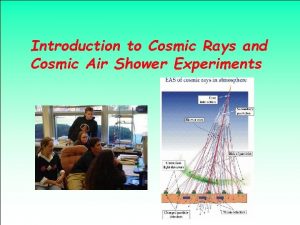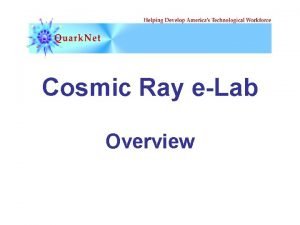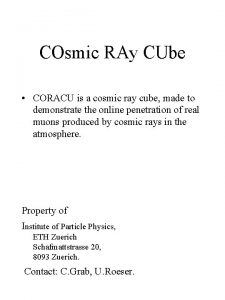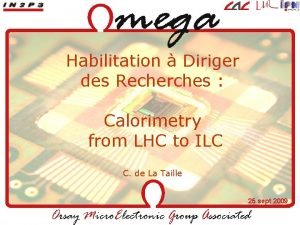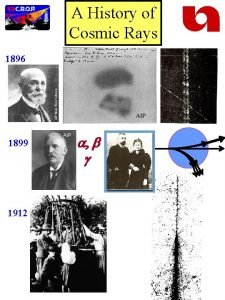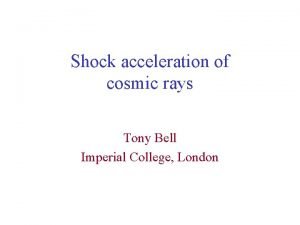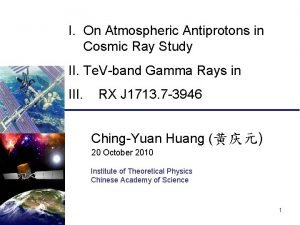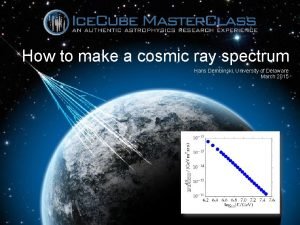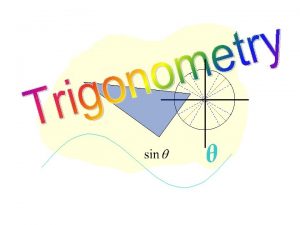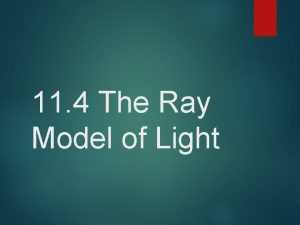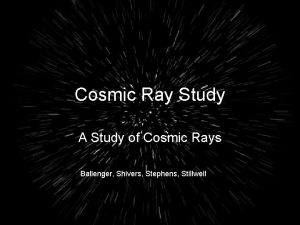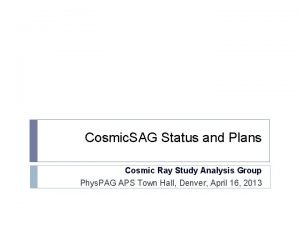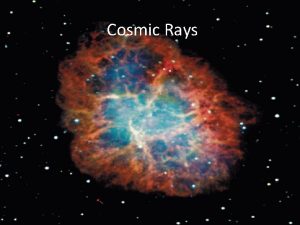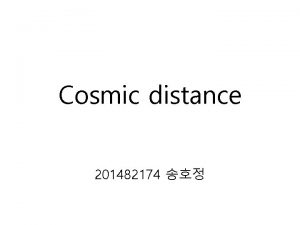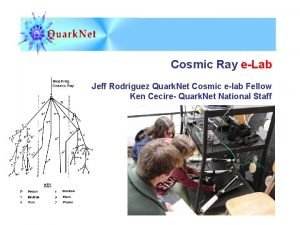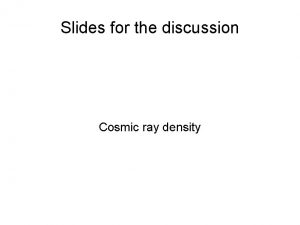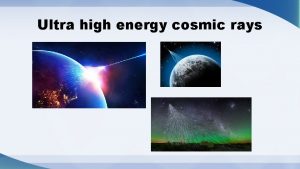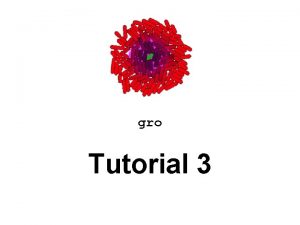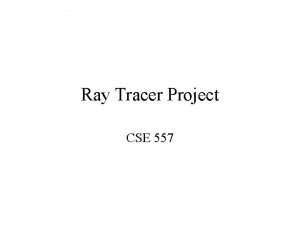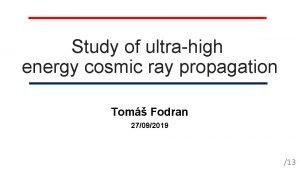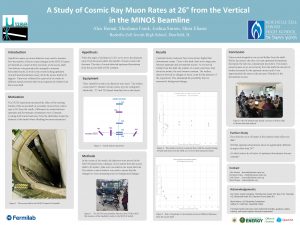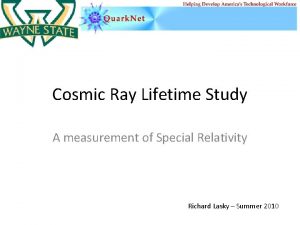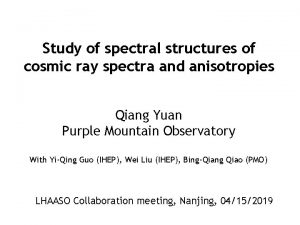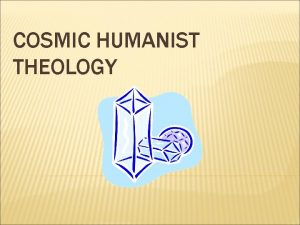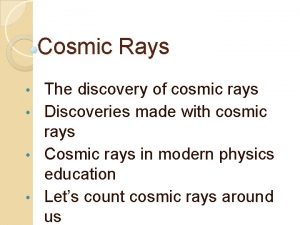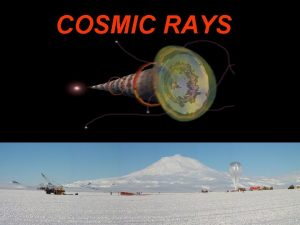A study of cosmic ray signals from the
















































- Slides: 48

A study of cosmic ray signals from the decay of mini black holes Claudio Corianò Università di Lecce INFN Sezione di Lecce, Italy

Collaborators Alessandro Cafarella (Lecce) Theodore Tomaras (Crete) Previous work on the simulation of airshowers with A. Faraggi (Oxford) Computational studies: INFN-LECCE Astroparticle Physics Cluster

Black holes in cosmic rays (Monte Carlo study) “Searching for Extra Dimensions in HECR”, A. Cafarella, C. C. , T. Tomaras, to appear , (2004) “ Cosmic Rays Signals from the decay of mini black holes: An analytical/monte carlo study” (2004) A. Cafarella, T. Tomaras, C. C. Simulations of extensive air showers “Large Scale Air Shower Simulations and the Search for new physics at AUGER” , A. Cafarella, C. C. , A. Faraggi, Int. Jour. Mod. Phys. A (2003)

Topics: The story of HECR and UHECR, briefly The Experiments How to describe a shower: lateral distributions and multiplicities How a shower can depend on the number of extra dimensions Conclusions


Above 10^14 e. V the flux is low Ground based experiments Long exposure Large aperture The Earth is a huge calorimeter. Incident cosmic radiation produces Extensive Air Showers (EAS) spread over large areas. 1938, Auger from the size of EAS suggestes that the spectrum extends up and beyond 10^15 e. V We have detected events of extraordinarily low flux (1 event/ Km^2/year above 10^19 e. V

Above 10^(18. 5) e. V a new population of CR of extragalactic origin dominates. The galactic component is more steeply falling; correlation with the galactic plane ( 4% anisotropy), anisotropy disappears above this point. Agasa ad Hires had previously been in disagreement regarding a set of UHECR events. The actual claim (Pylos, ISVHECRI 2004) Is that the two sets do not exclude one another.

The integrated flux is well described by a local power law over a large energy range For a given spectral index x. Only at low energies are the primaries detected directly Flux changes dramatically over the entire energy range

One of the earliest theories on the acceleration of cosmic rays was proposed by Enrico Fermi in 1949. It became known as the "Second Order Fermi Mechanism". In this model, particles collide stochastically with interstellar clouds in the interstellar medium. Those particles involved in head-on collisions will gain energy (similar to a sling-shot process used to accelerate spacecrafts around planets), and those involved in tail-end collisions will lose energy. On average, however, head-on collisions are more probable. In this way, particles gain energy over many collisions.




A Cafarella, C C ccf

A Cafarella, C. C. (2003) ccf

A. Cafarella, CC CORSIKA + QGSJET Radial Distributions

N=10 m Eq A. C. and C. C. Multiplicities over the entire spectrum

Argentina, Mendoza Province Cerenkov Tanks

Fluorescence detectors




New Physics: Energy in UHECR goes up to 1, 000 TEV Z- burst mechanism String Relics or any top/bottom mechanism And the last proposal: mini Black Hole formation

First Scenario: Extra Dimensional Theories § Theories with extra dimensions predict a gravity scale close to the electroweak scale, say 1 Te. V, which can be accessed at future colliders (even the LHC). Even more so, in UHECR, we should be able to cross this (and the supersymmetry) scale by a large amount. Gravitational and Supersymmetric effects should appear at some stage in the dynamics of the extensive air showers. How?

Extra Dimensional models String theories live in D=10= 9(space) +1(time) spacetime dimensions. ED models assume a spacetime structure in which p coordinates describe the brane and (9 - p) are the remaining “extra” space coordinates. These extra coordinates are characterized by a compactification radius R which can be of a millimeter (the extra dimensional space is called: the bulk). Gravity can go into the bulk (ED) Matter stays on the brane. The Planck scale we are used to (MPlanck) is not the true scale for gravity.

There can be, additionally, “Kaluza Klein dimensions” Example: D=10 = 9 +1 = (3 +1) + (Nkk) + n Nkk= Kaluza-Klein dimensions D= 4 + n n= number of extra dimensions. We can have up to n=6 extra dimensions (Nkk=0) The scale of gravity is lowered (M *) << MPlanck Gravity becomes strong as soon as we reach M*, which is the true scale for gravity. It can be of the order of the electroweak scale (say M* = 1 Te. V). Gravitational effects which ordinarily occur for very large masses, say 1. 5 times the solar mass, are now possible at an equivalent energy E > M*

RH = radius of the horizon (for the Sun is few km) Example: “squeeze the sun” within a sphere of about 3 km you get a BH For the Earth is few cm Very High Energy Neutrinos are the natural candidates for mini black hole formation. For ED theories an horizon of 10 -3 fm can form if the impact parameter of the collision is of this order. Giddings and Thomas, Nambu Gravitational schock-waves Factorization scales. In pp collisions it is required larger center-of-mass energy. For neutrino primaries The probability is larger (ν p collision)

Various types of solutions Schwarzschild (static, uncharged) Reissner-Nordstrom (static, charged) Kerr (rotating) Boyer- Lindquist (rotating and charged) Large activity on Extra-D black holes in the last 4 years. Kanti and March-Russel Anchordoqui, Feng, Shapere Ahn, Ave, Cavaglià and Olinto Truly, we need angular momentum and the Kerr solution should be the starting point of the all analysis.

PHASES in BH DECAY 1) Balding Phase ( loose of hair, charge and other quantum numbers) 2) Spin down phase (from Kerr to Schwarzschild) 3) Schwarzschild phase (semiclassical Hawking description) 4) Planck phase (unknown) REMARKS: a) Multiplicities are computed only approximately. b) There are modifications of various types. For instance a generalized undetermination principle (GUP) can lower the multiplicites c) Issues regarding the presence of a chromosphere in BH decay (Heckler)

4 +n Schwarzschild metric (Myers and Perry) Horizon radius Multiplicities (Dimopoulos and Landsberg)

The only way to attack this problem is to use the semiclassical Hawking description, where a BH is viewed as a black body emitting thermal Blackbody radiation with a given characteristic temperature. Computed greybody factors (i. e. absorption/emission cross sections of black holes) analytically and numerically for most cases (with no angular momentum).

Mass loss as a function of time

Energy is lost also in the bulk. These are gravitons which escape detection and the energy which is available for the Actual fragmentation is lower. Harris and Kanti

Perturbations in BH backgrounds 1) Propagation of spin 0, spin ½ , spin 1 in BH backgrounds for D= 4 +n. Near horizon limit –matching- to the asymptotic r limit. analytical results only available for small frequency. Numerical solution of the Teukolsky (4+n) equation. The equations are reformulated in the twistor Newman- Penrose formalism and solved numerically 2) Gravitational perturbations (gauge invariant formulation) recently formulated in 4+n by Kodama and Ishibashi. Regge-Wheeler type equations (separation of radial and angular coords) 3) In 4 D, quasi normal models (ringing modes) for the detection of gravitationla waves. Cen be computed using Leaver’s method of continuous fractions

Black body entropy modified by greybody factors Decay time

Multiplicities depend on the final phase of the black hole (DL= Dimopoulos and Landsberg) (N(n) Cavaglià, S. Das) LHC phenomenology critically depends on the multiplicities. Milder dependence for High Energy Cosmic Rays

Geometry along the vertical directions (zenith=0)

Uncorrelated decay of the BH into partons: multimonomial distribution p= decay probabilities (Cafarella, C. C. , Tomaras) We compute the total probability to produce a hadron h of a given energy E*h. Fragmentation Functions D(x, Q)

The BH decays into partons and leptons. The partons hadronize as soon as they cross the horizon. We use QCD fragmentation functions D(x, Q), evolved to the scale E/N A. Cafarella, C. C, (CPC, 2004)

Depth= gr/cm^2 Cascade equations. can bypass Monte Carlo studies (in part) Drechsler and G. Farrar Dark Matter emission (LSP) should be studied by these equations (C. C. ) We need to superimpose showers and combine them statistically on the gorund.

Understanding the Structure of the Air Shower We define suitable geometrical variables in our simulations which we use in order to characterize the shower Geometrical center of the shower Multiplicities of the shower at various observation levels Binning on the MC done on sets of 80 simulations per event. At the GZK cutoff we generate a huge dataflow.


ratios hadronic/em

Cafarella, Tomaras, C C





IF the ED scenario is correct, then we should see mini BH produced at hadron colliders and in cosmic rays. We have analized the lateral distributions and the multiplicities of cosmic rays events mediated by the presence of a resonance of this type. Larger multiplicities, wider spreading compared to ordinary events of comparablle characteristics. Open issues: gravitational emission. horizontal airshowers
 Cosmic ray showers
Cosmic ray showers Cosmic ray elab
Cosmic ray elab Cosmic rays
Cosmic rays Bit flip cosmic ray
Bit flip cosmic ray Cosmic ray
Cosmic ray Cosmic ray spectrum
Cosmic ray spectrum Cosmic ray
Cosmic ray Cosmic ray
Cosmic ray Animals and human language chapter 2
Animals and human language chapter 2 Informative signals example
Informative signals example Communicative signals and informative signals
Communicative signals and informative signals Tan 30 unit circle
Tan 30 unit circle Ray model of light
Ray model of light Ray casting vs ray tracing
Ray casting vs ray tracing Hình ảnh bộ gõ cơ thể búng tay
Hình ảnh bộ gõ cơ thể búng tay Ng-html
Ng-html Bổ thể
Bổ thể Tỉ lệ cơ thể trẻ em
Tỉ lệ cơ thể trẻ em Gấu đi như thế nào
Gấu đi như thế nào Tư thế worms-breton
Tư thế worms-breton Hát lên người ơi alleluia
Hát lên người ơi alleluia Kể tên các môn thể thao
Kể tên các môn thể thao Thế nào là hệ số cao nhất
Thế nào là hệ số cao nhất Các châu lục và đại dương trên thế giới
Các châu lục và đại dương trên thế giới Công thức tính thế năng
Công thức tính thế năng Trời xanh đây là của chúng ta thể thơ
Trời xanh đây là của chúng ta thể thơ Mật thư anh em như thể tay chân
Mật thư anh em như thể tay chân 101012 bằng
101012 bằng độ dài liên kết
độ dài liên kết Các châu lục và đại dương trên thế giới
Các châu lục và đại dương trên thế giới Thể thơ truyền thống
Thể thơ truyền thống Quá trình desamine hóa có thể tạo ra
Quá trình desamine hóa có thể tạo ra Một số thể thơ truyền thống
Một số thể thơ truyền thống Cái miệng xinh xinh thế chỉ nói điều hay thôi
Cái miệng xinh xinh thế chỉ nói điều hay thôi Vẽ hình chiếu vuông góc của vật thể sau
Vẽ hình chiếu vuông góc của vật thể sau Biện pháp chống mỏi cơ
Biện pháp chống mỏi cơ đặc điểm cơ thể của người tối cổ
đặc điểm cơ thể của người tối cổ V. c c
V. c c Vẽ hình chiếu đứng bằng cạnh của vật thể
Vẽ hình chiếu đứng bằng cạnh của vật thể Fecboak
Fecboak Thẻ vin
Thẻ vin đại từ thay thế
đại từ thay thế điện thế nghỉ
điện thế nghỉ Tư thế ngồi viết
Tư thế ngồi viết Diễn thế sinh thái là
Diễn thế sinh thái là Dot
Dot So nguyen to
So nguyen to Tư thế ngồi viết
Tư thế ngồi viết Lời thề hippocrates
Lời thề hippocrates
